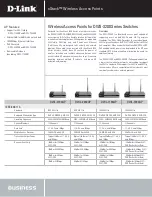
Chapter 2. Safeguarding Your Network
|
27
N150 Wireless Router WGR614v11 User Manual
Configuring WEP Wireless Security
WEP Shared Key authentication and WEP data encryption can be defeated by a determined
eavesdropper using publicly available tools.
WEP offers the following options:
•
Automatic
. With the Automatic option, the router will try both Open System and Shared
Key authentication. Normally this setting is suitable. If it fails, select
Open System
or
Shared Key
. You can also refer to your wireless adapter’s documentation to see what
method to use.
•
Open System
. With Open System authentication and 64 or 128 bit WEP data encryption,
the WGR614v11 router
does
perform data encryption but
does not
perform any
authentication. Anyone can join the network. This setting provides very little practical
wireless security.
•
Shared Key
. With Shared Key authentication, a wireless device must know the WEP key
to join the network. Select the encryption strength (64 or 128 bit data encryption).
Manually enter the key values, or enter a word or group of printable characters in the
Passphrase
field. Manually entered keys
are not
case-sensitive, but passphrase
characters
are
case-sensitive.
To configure WEP data encryption:
Note:
If you use a wireless computer to configure WEP settings, you will
be disconnected when you click
Apply
. You must then either
configure your wireless adapter to match the wireless router WEP
settings or access the wireless router from a wired computer to
make any further changes. Not all wireless adapter configuration
utilities support passphrase key generation.
1.
Select
Wireless Settings
under Setup in the main menu.
2.
In the Security Options section, select
WEP
. The WEP options display.
Figure 3.
















































